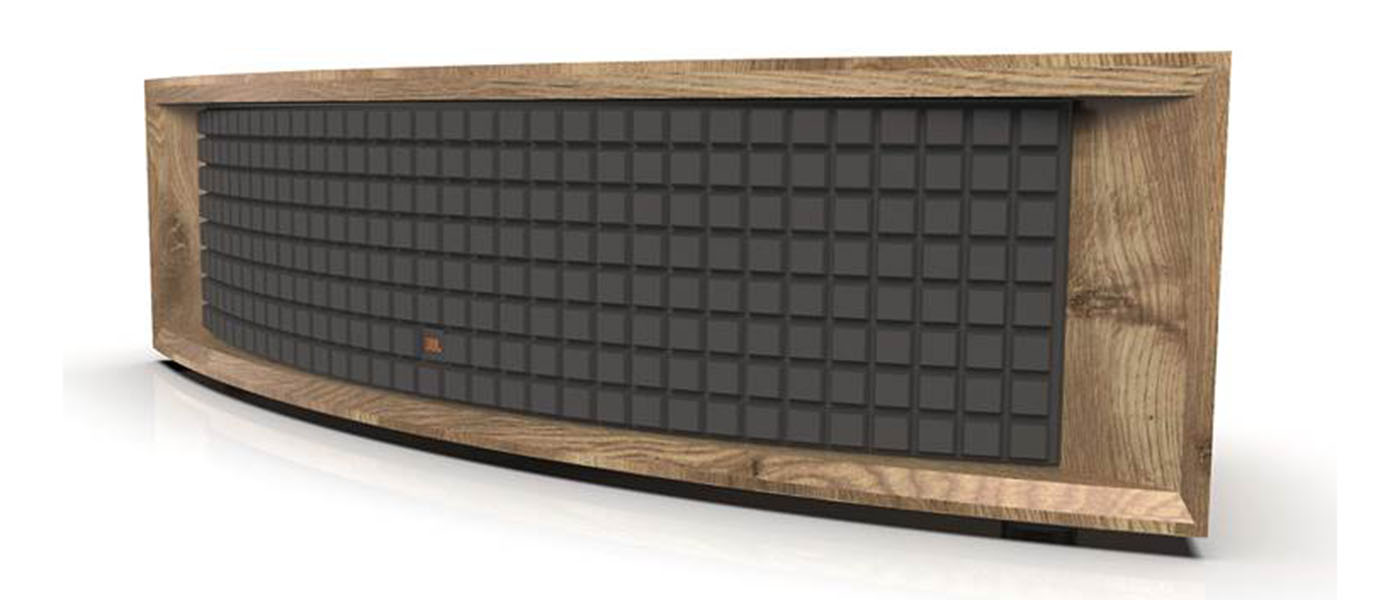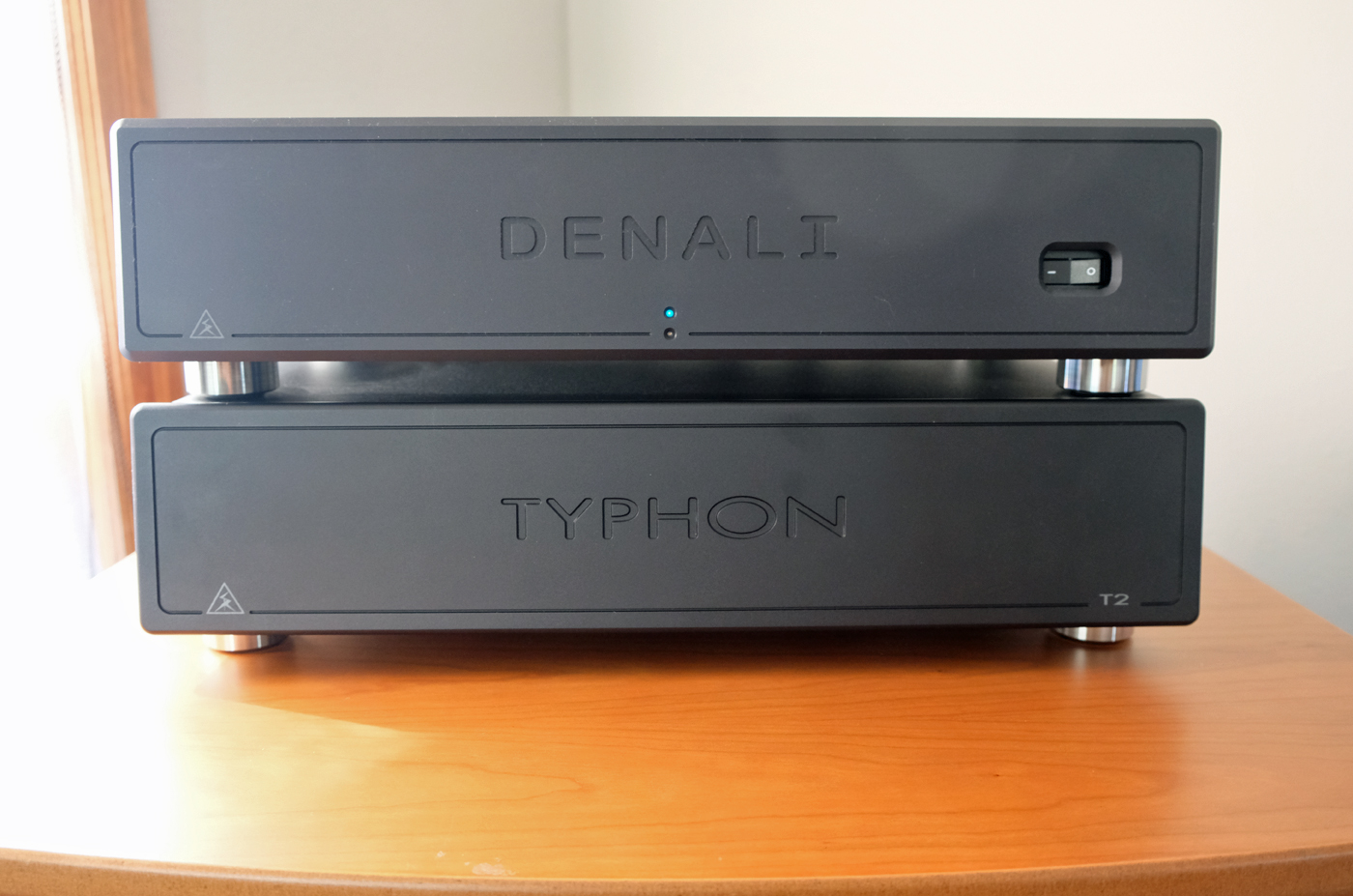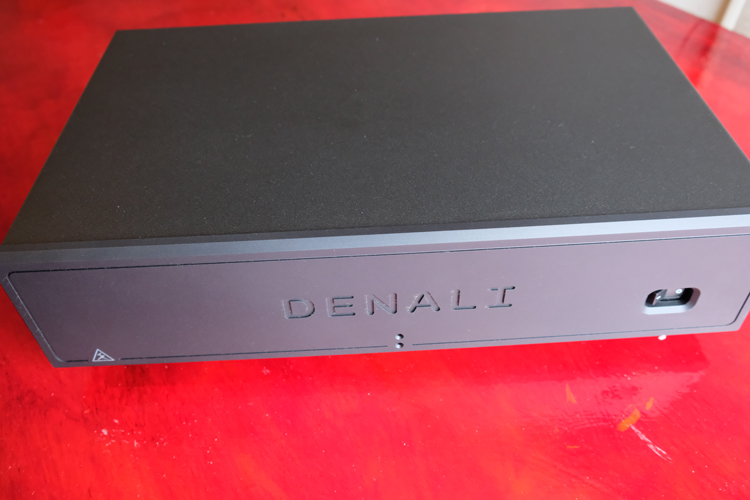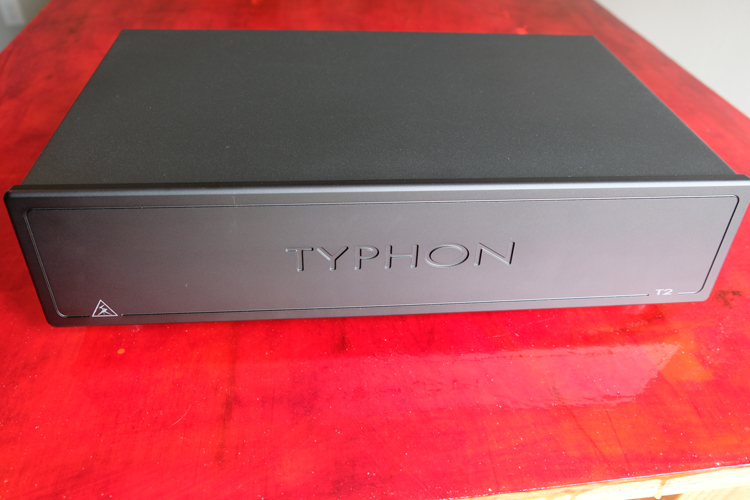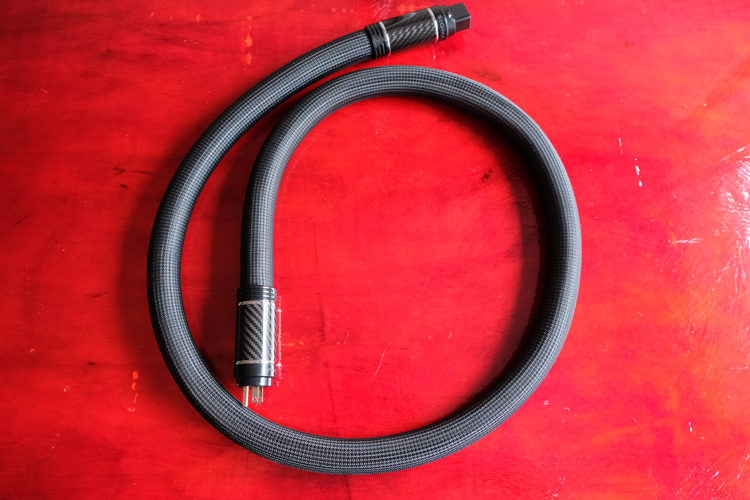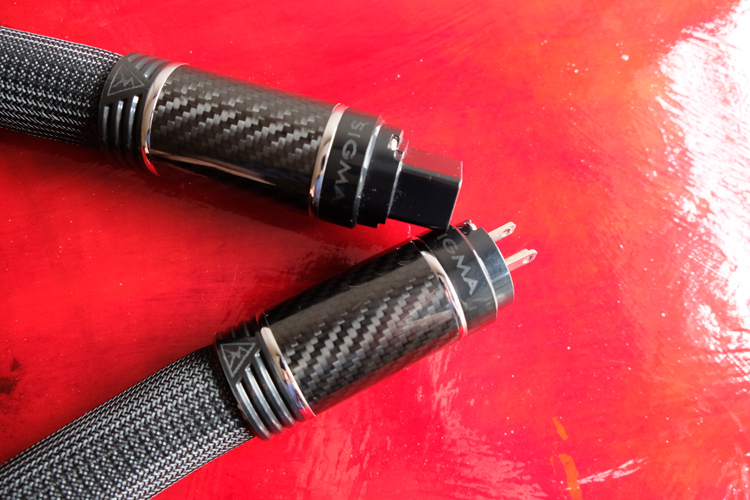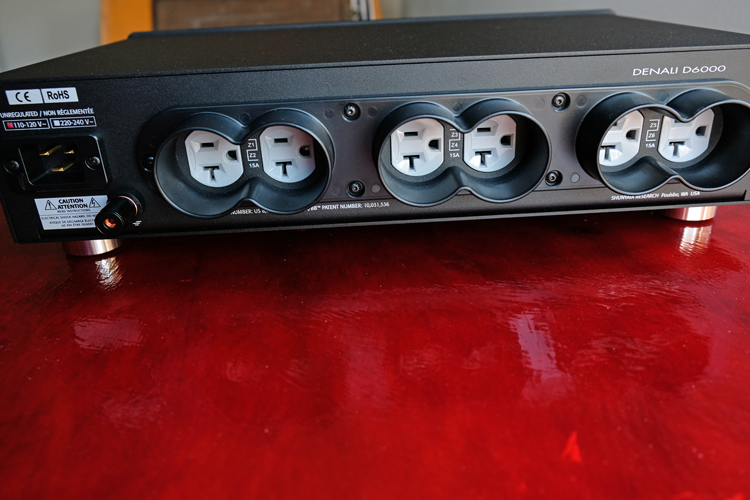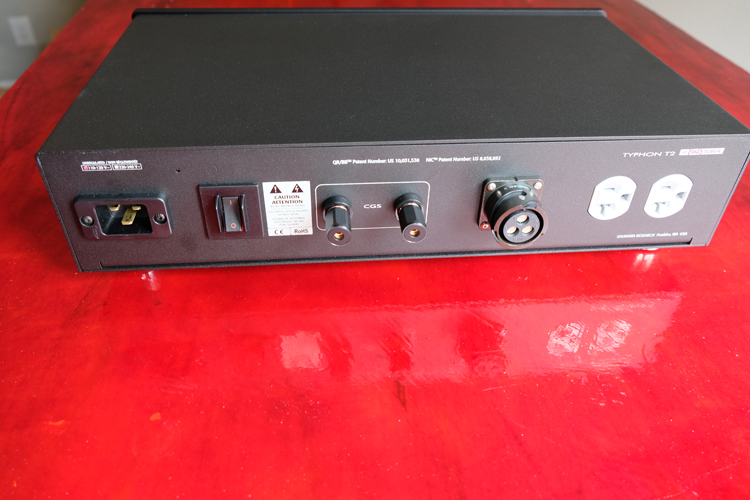The Shunyata Denali 6000/S v2 and Typhon T2 power distributors are the state of the art in this space. Numerous patents document the innovation and dedication that this company brings to sound reproduction and sensitive medical measurements. The power distributors are designed to be used with Shunyata’s power cords. The Sigma XC and Sigma NR v2 cords might represent the sweet spot in line. I brought all of these together in my system – using a Typhon T2 Reference Umbilical to connect the Denali and Typhon – creating a monumental shift in my living room.
SHUNYATA Denali 6000/S v2, Typhon T2 Power Distributors Highlights
- Reveals new depth and nuance to any recording.
- Unique technology not found elsewhere.
- Excellent build quality.
Shunyata designs and builds its products way up near the top of the Olympic peninsula. Founder Caelin Gabriel, unsatisfied with his stereo’s sound and armed with extensive knowledge about signal integrity from his years of service to the US government, began experimenting with cables he built in his kitchen. Here we are, twenty-some years and numerous patents later, I think he’s on to something.
Maximum Voltage:
90-125 VAC r.m.s. unregulated (US)
220-240 VAC r.m.s. unregulated (EU, AS, AU)
Input Current Ratings:
Maximum Continuous Current: 20A (US, AS)
Maximum Continuous Current: 16A (EU, AU)
Output Current Ratings:
Max Current/Outlet: 20A (US, AS)
Max Current/Socket: 16A (EU, AU)
Transient Suppression:
Maximum Transient Protection: 40,000 A @ 8/50 μs
Over-Current Protection:
Hydraulic Electromagnetic Breaker
Wiring System:
8 gauge ArNi® VTX™ Buss System
10 gauge ArNi® VTX™ Wiring
Ratings:
600 V 105° C
Noise Suppression:
Input to Output (100 kHz – 30 MHz): > 50 dB reduction
Zone to Zone (100 kHz – 30 MHz): > 60 dB reduction
Outlets & Connectors:
Zones of Isolation: 6 Zones
Inlet: IEC C19RUS Outlets: 6 NEMA5-20R
AS Outlets: 6 NEMA 5-20R
EU Sockets: 6 CEE 7/3
AU Sockets: 6 AS/NZS 31123
Vibration Control:
Vibration dampening panels (internal)
AC outlet dampening gaskets
Shunyata Isolation SSF-38 Footer
Construction:
Aluminum and steel chassis
Anodized, aluminum faceplate
GPNR:
Length: 80 mm
Diameter: 38 mm
Dimensions:
Width: 17.0 inches (43.2 cm)
Depth: 10.0 inches (25.4 cm)
Height: 4.4 inches (11.2 cm)
Weight: 17.5 lbs (7.95 kg)
MSRP:
PRICE: $6000
Maximum Voltage:
90 – 125 VAC r.m.s. unregulated (US)
220-240VAC r.m.s. unregulated (EU, UK, AS)
Input Current Ratings:
US/AS maximum continuous current: 20A
US/AS maximum continuous current: 30A (optional)
EU/AU maximum continuous current: 16A
UK maximum continuous current: 16A
Output Current Ratings:
US/AS max current/outlet: 15A
EU max current/socket: 16A
UK max current/socket: 13A
Transient Suppression:
Maximum transient pulse 40,000 Amps @ 8/50 μs
Over-Current Protection:
Hydraulic electromagnetic breaker
Wiring System:
8 gauge ArNi® VTX-Ag™ buss system
10 gauge ArNi® VTX-Ag™ wiring
Ratings: 600 V 105° C
Noise Suppression:
Input to Output (100 kHz – 30 MHz): > 50 dB reduction
Zone to Zone (100 kHz – 30 MHz): > 40 dB reduction
Connectors & Sockets:
Inlet: IEC C19R
Inlet: Proprietary 30A Amphenol (30A Model only)
Twist-lock outlet: Proprietary Amphenol
US outlets: 2 NEMA 5-20R
AS outlets: 2 NEMA 5-20R
EU sockets: 2 CEE7/3
UK sockets: 2 botanicaSEATTLE 1363 (3 Pin)
Isolation Zones:
3 zones
Vibration Control:
Vibration dampening panels (internal)
AC outlet dampening gaskets
Shunyata Isolation SSF-38 Footer
Construction:
All aluminum chassis
Anodized, brushed aluminum faceplate
Dimensions:
Width: 17 inches (43.2 cm)
Depth: 10 inches (25.4 cm)
Height: 4.4 inches (11.2 cm)
Weight: 17.5 lbs (7.95 kg)
MSRP:
$6000
Conductors:
8-gauge VTX-Ag
Dielectric:
fluorocarbon
Connectors:
Proprietary Twist-Lock Amphenol Connector
CopperCONN C19
Standard Length:
0.50 meters
KPIP Processing:
4-days
Safety Assurance:
Continuity and Polarity Tests – by two technicians
HiPOT Tests for each cable
Cable spools tested for insulation breakdown @ 4,000 VAC
MSRP:
$1250
Cable Type:
VTX-Ag 06
Conductors:
ArNi® / OFE
Dielectric:
fluorocarbon
Connectors:
CopperCONN™ Carbon-Fiber
Noise Reduction:
N/A
HARP Module:
N/A
KPIP Processing:
4-days
Standard Length:
1.75 meters
Safety Assurance:
Continuity and polarity tests – by two technicians
HiPOT tests insulation breakdown @ 4,500 VAC
MSRP:
$3250
Cable Type:
VTX-Ag 06
Conductors:
ArNi® / OFE
Dielectric:
fluorocarbon
Connectors:
CopperCONN™ Carbon-Fiber
Noise Reduction:
> 12 dB @ 1 MHz
HARP Module:
N/A
KPIP Processing:
4-days
Standard Length:
1.75 meters
Safety Assurance:
Continuity and polarity tests – by two technicians
HiPOT tests insulation breakdown @ 4,500 VAC
MSRP:
$3500
Website:
SECRETS Tags:
shunyata, power conditioner, power cord
It’s hard to know where to start in describing the technology in Shunyata products, and hard to know where to stop. There is a lot of tech and it is not the same as in other companies’ power cords and conditioners. Typical power conditioners are made up of components that I learned about in school – transformers, capacitors, and inductors. With Shunyata, we get into new stuff, quite a bit of it.
In some cases, the purpose of a particular Shunyata technology is similar to those components that we already know – Shunyata’s QR/BB™ module “possesses the ability to act as an electric charge reservoir”. This sounds like what a capacitor does – indeed the patent for QR/BB technology starts with a description of how a capacitor functions in a power conditioner but also mentions the problem with that application – capacitors are great at delivering voltage, limited at delivering current. This well-known issue even has a name for those in the power business: Power Factor. You’ll see ‘Power Factor Correction’ mentioned here and there – but the methods for doing that (correcting) are limited. Until now. This is how it goes with Shunyata – the founder Caelin Gabriel comes up with real solutions to problems that others leave unsolved. If I understand what QR/BB is doing it solves the power factor problem with a structure that seems pretty similar to a capacitor but manages to store more electrons (needed for current) than a regular capacitor would. In addition, QR/BB performs this function without adding the reactance that a capacitor would. You can think of reactance as frequency-dependent resistance that is inherent in capacitors.
Secrets Sponsor
In the patent for QR/BB, there is a brief description of what I think of as “The Problem” – that’s “The” with a long ‘e’. Here is “The Problem”: “In a typical power supply for an electronic device, the power supply draws current from the power line in pulses. Current is only drawn at the positive and negative peaks of the AC voltage waveform. The storage capacitors for the power supply maintain a relatively stable DC voltage, and the rectification diodes only turn on when the AC waveform voltage exceeds the stored voltage level in the capacitor array. When the rectification diodes do turn on there is a high surge of current drawn *directly* from the AC power line. The sudden demand for instantaneous current from the power supply can exceed the capacity of the power line to deliver current efficiently…” It goes on but that is the gist of it. (Note: I added the italics and the “*directly*” in there). So, the notion that the DC power supply is solving all of the issues is not correct. It shouldn’t be surprising that using diodes to rectify AC to DC and then storing a charge with some amount of capacitance is not a perfect process, far from it.
The need to draw directly from the mains supply at certain times is part one of “The Problem”. Part two is what happens when the valves (diodes) close.
Let’s re-word that whole thing in terms of the water pipe analogy that works pretty well for AC power delivery. The basic analogy is there is a big pipe with fresh water from your local municipality. It’s got sufficient pressure behind it to get the water where it needs to go. The more one faucet takes the less is available for others but if the pressure is enough you wouldn’t notice – it all depends on the size of the pipes etc., etc. Okay, what is missing from that analogy is how the small pipes draw from the big pipe. Turning on a faucet for a steady flow does not mimic what is happening with a power supply that is converting AC to DC and using that to drive an audio signal (with its variations). You can come close to what a rectification circuit is doing if you were to modify the high-speed on/off faucet in some clothes washers and make them open and close multiple times in a second – thereby causing tremendous water-hammer and rattling your pipes, bigly. Back in the electronics world: quite simply, as the rectification circuit opens and closes, noise is sent back into the mains, affecting all the other components. This is a widely ignored issue.
The various Shunyata technologies (I’m only listing some of them here) in both the power distributors and the power cords, combine to not only eliminate the general noise that is coming into your house from God-knows-where but this very local, very powerful, component to component interference. Shunyata calls this combined effect: CCI Noise Reduction. The bigger the power supply and the more erratic the load on the supply, the bigger the problem.
But there is more, much more. It’s as though Caelin Gabriel is as obsessed with good sound as you and I are, dear reader.
The first item listed on Shunyata’s technology page is the NIC – Noise Isolation Chamber (once again, patented). This is a cylinder filled with a ferroelectric substance. The main lines are passed through this substance. Getting back to the water analogy – this is like the activated carbon in a countertop filter that absorbs all the things you don’t want, in the case of water, it absorbs chemicals. In the case of electrical mains supplies, a ferroelectric substance absorbs high-frequency noise. I find it rather surprising that such a solution even exists, but I’ll take it. Not surprisingly, Shunyata has refined the approach in a couple of ways. One is the routing of the wires through the cylinder to maximize the effectiveness of the substance. The other is the substance itself: ZrCa-2000. That’s Shunyata’s trademarked name for a proprietary material, I’ll simply quote Shunyata on this one: “ferroelectric, crystalline materials that act on the electric field similar to how ferrite (ferrous metals) acts on the magnetic field. Both absorb high-frequency noise; however, the ZrCa-2000™ compounds do so without the negative sonic side effects commonly associated with the use of ferrite in an audio system.” Enough said.
Secrets Sponsor
I do want to mention a couple of other things technology-wise – the Denali 6000s/v2 and Typhon T2 incorporate vibration control. Often, vibration control is a token bit of material glued to the inside of a component’s cabinet. In this case, it is serious. The cabinets yield a very satisfying thud when knuckle-wrapped. Also, the circuit breakers – Shunyata power distributors use a “Hydraulic Electromagnetic Breaker” rather than the more common fuse or thermal breakers. With the latter, their impedance changes with the load which is really undesirable for audio. Once again, I see Shunyata going the extra mile to solve problems that are often neglected in other components.
More, more, more: A custom wire geometry (arrangement) with silver wires in the middle, surrounded by copper wires, separated by fluorocarbon insulation, the sum total is called VTX-Ag. Most copper-silver combinations out there have a silver coating over copper but not in this arrangement. The all-important connectors are pure copper, with no plating. Ok, I give, it’s too much to cover here. See the Shunyata technologies page: https://shunyata.com/power-distributor-tech/
Overall, Caelin Gabriel holds about a dozen patents in relation to power cords and distributors and by my reading, they are real inventions. For various reasons, the US patent office has been overwhelmed for most of our lifetime and many patents are awarded for somebody simply doing something. The thing might even be obvious and a copy of something already out in the world. The Shunyata patents aren’t those.
You will also find on the Shunyata site links to the many recording studios now using complete Shunyata systems for all of their components – folks like Rick Rubin, David Gilmour’s Astoria recording studio, and Skywalker Ranch, give some rather hardy endorsements. Find the complete list and some videos here. Then there is the very important and completely visual evidence of the improvements that Shunyata’s products can give – the medical business. “CIS” for Clear Image Scientific – so your doctor can see your heart activity without a crap-ton of noise added to it. Maybe something you would like your doctor to have. Scroll down just a little on that page for the visuals.
Note that I’m reviewing here two Shunyata power distributors, either of which can be used standalone. Indeed, I started with the Denali 6000s/v2, connected to the wall with a Sigma XC (no need to use an NR cord for the input to the power distributor). I used the Denali standalone for a few weeks before the Typhon T2 arrived. At that point the Sigma XC went from the wall to the Typhon and the Typhon fed the Denali via the 8-gauge VTX-Ag Reference umbilical. Most of my listening was with the combo. The two boxes do not simply represent more available outlets, the patented QR/BB circuit within the T2 is similar in size to what is found in the big Everest tower but in the case of the Typhon T2, it is optimized not only for the connected components but to feed the Denali.
All of these cords are big. They are bendy enough that if your components are more than six inches from the wall you shouldn’t have any issues with getting them where they need to go. You might feel a little uncomfortable with the final twist, however. It’s very likely that for some of your components when you get to the component connection end of the six-foot length, the IEC connector on the cord will want to be 180 degrees from where it needs to be. Go ahead and twist as needed was the word from Richard Rogers (US Sales Manager for Shunyata). I did as instructed, it was a little scary, but everything is working fine.
Many factors might go into which configuration of power conditioners you might want. Cost, of course. The number of outlets is a big one – my maximalist system with mono-block amps used up all six outlets in the Denali and then some. I had to leave the tuner and CD player unconnected until the Typhon arrived. There is also the matter of shelf space. I remember when I first saw the Denali Everest tower models in a showroom – I thought Shunyata was making an attention grab. I eventually figured out that having your power cords gathered and organized vertically by a floor-standing tower makes a ton of sense and spares a shelf. (The S in Denali 6000/S is for “Shelf”, and the 6000 is for 6 outlets.)
Not every system is maximalist, however. If yours leans towards minimalism, you might be able to use a Typhon T2 only. I noticed that Shunyata is coming out with a couple of new distributors – The Gemini 4 and Gemini 8. The whys and wherefores of which is right for you get complicated quickly. If you want to get started with just a single cord, I would say start with your amp. Probably you’ll want an NR cord, there are only a few amps that seem to prefer the XC cords, talk with your dealer. For sure use an XC on the input side of a power distributor though. Shunyata power distributors have their own, specially tuned, NR filters at each outlet so there is no need to filter the input side.
Before the power distributors arrived, I started by arranging the cords that I had previously purchased in the correct manner (thanks to Grant Samuelson, Marketing and Sales Manager at Shunyata). The correct manner, generally, is to have the NR cords connected to the highest-current components – the amps. I had the reverse; NR cords were connected to the source components (Simaudio Moon P8 preamp and Simaudio Moon 810LP phono pre) and had Alpha HC cords (a couple of generations back in the Shunyata line) connected to my vintage Simaudio W6 monoblocks (all of the Simaudio stuff is connected with balanced Nordost interconnects). I was enjoying the heck out of this setup but upon correcting the power cord arrangement, my notes were this: “Noise floor about 30 stories lower, can hear cymbals (as though they weren’t even there before), voices more nuanced, same for snare drums, the bass goes lower and is more defined.” This was all through my Furman Reference 20i power conditioner, connected to the wall with an Alpha XC.
The Denali 6000/S v2 arrived along with a Sigma XC for a more proper connection to the mains. Before plugging in the Denali, I tried this cord with the Furman and indeed there was more improvement. Now I was facing the dreaded break-in period. In the case of Shunyata power distributors, it is mostly the NIC chambers with the ZrCa-2000™ compound that have to settle from the vibrations of shipping that need this time. It can be hurried along a little by plugging small fans into the power distributor for three to four days, but I lacked the patience for this. I started listening right away, breaking in over about a week.
For my first serious listen with the Denali, I used an old favorite, Jenny Lewis’ album On the Line, first track: “Little White Dove”. I threw up my hands – why have I never heard notes this low from my system before? I also put on one of my reference discs – When It Falls by Zero 7. There are parts of this record where my thoughts were that the band was aiming to have a scratchy background similar to an uncleaned, abused vinyl LP. Now I could hear that these sounds were actually something of their own, with a rhythm to them. There was more soundstage depth and voices occupied a larger space. Whether the drummer was leading or lagging became more apparent.
Okay, finally, after about a week, with the Denali 6000/S v2 broken in, there was more of the above, much more. The voices and the lyrics they were singing became much clearer. Even I can pay attention to lyrics when they’re this distinct from the band. The soundstage was much wider extending well beyond my speakers (Daedalus DA 2.1, connected with Kimber 8TC). My record player is a Nottingham Spacedeck with a Dynavector XX2 Mk2.
Thinking back to when the Furman was in place, I think there was a coloration with that power conditioner – a sort of veil over voices especially. Also, certain bass notes were somewhat boomy. All corrected with the Denali 6000/S v2. It all got me thinking about the ‘space between instruments’ that we reviewers often talk about. With the Denali it was less a matter of a bubble around each instrument but rather a much more natural presentation where it’s more of: “There’s a guitar”, “Oh, and there are the drums” and “The singer is right there” and there is no thought to how the sounds are blending or not blending. They are just there, sounding very natural. I think it’s possible to get caught up in the sound of ‘a bubble around each instrument’ without realizing it’s really a bit of an artifact from less-than-optimal rendering.
Okay, let’s add the Typhon T2. The very similar, stackable box arrived a few weeks later, also needing its own break-in period. I accelerated it as much as possible with a couple of fans. After a few days, I replaced the fans at the two outlets of the Typhon with the W6 monoblocks, once again connected with the Sigma NR v2 cords. This freed up two outlets on the Denali which I used for my Parasound CD1 and tuner, both connected with some very old Shunyata Venom cords.
Then I played records, lots of them.
Starting with Zero 7 again in order to make comparisons, my notes say: “This is silly”. As in silly-good and why didn’t I do this before? Once again, I heard more cymbals than with any of the previous setups. Treble in general had/has a translucent quality – kind of a vague term I know – it’s a very pleasant treble quality, I can tell you that. Grain-free with exquisite detail is another way to say it. I heard more nuances in each of the instruments. On “Warm Sound” I heard for the first time a heart-beat quality to the bass drum that is a huge component of the song and its meaning. Unheard until now.
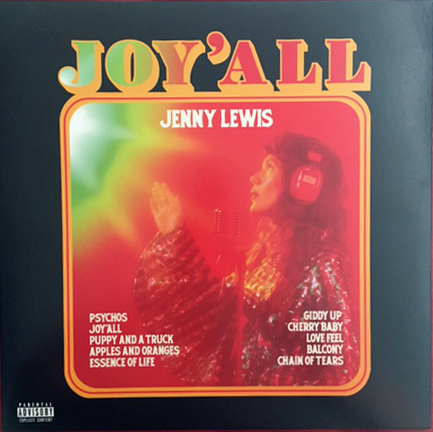
Jenny Lewis “Joy’All”
Any new Jenny Lewis record is a cause for celebration. The heart-laid-bare songwriting and expert musicianship that we expect are all over this one. It’s a mellow thirty-two minutes. Jenny’s level of rocking out is gently declining in an age-appropriate manner, but her recordings have always been excellent. If you want to rock out and be impressed by your stereo, get her second solo record: Acid Tongue. On Joy’All there is a country influence but the inventive music swamps that right out. The bass guitar is smooth and funky and a driving force on many of the tracks. It was hard not to be aware of Ms. Lewis’ excellent voice from way back but with the Denali/Typhon T2 combo I have come to appreciate (get blown away by) the artistry in her singing – as with other recordings, the Denali / Typhon T2 reveals nuances and inflections that were previously unnoticed.

Erykah Badu “Mama’s Gun”
A little bit of internet research told me that the version I found – imported from Germany because that’s where a new copy was available – was mastered by Bernie Grundman and pressed at the well-regarded RTI record pressing plant in California. This is not mentioned on the album sleeve, apparently, it can be deduced by the scratchings on the run-out groove. I’ve never gone so far as to squint at the run-out groove of my records, but if anyone would drive me to do that it would be my beloved Erykah. This is one record that I hadn’t heard before I had the Denali / Typhon T2 stack in place, but I can tell you that the snare-drum roll at the start of the track called “Booty”, is mesmerizing with these power distributors and the associated cords in place. Yes, “Booty” is mesmerizing.
I think it is proper and expected that the drummer will keep the two sticks very close together, striking nearly the same spot on the drumhead, while doing such a roll. Well, that is part of the soundstage and indeed it was very apparent that the sticks were right next to each other – as though I could see them. The drumming expands to the rest of the kit soon after and like other drum kits on other records, I am now hearing the front-to-back placements of the various drums. I got too excited to keep good notes eventually, but I think it is this record that I heard something I never would have thought of – when a high-hat opens or closes, there is some progression, left to right and/or front to back as the two circular pieces of metal meet up or come apart. I never thought the front-to-back part of this would be the kind of thing I could hear from a stereo. Until now.
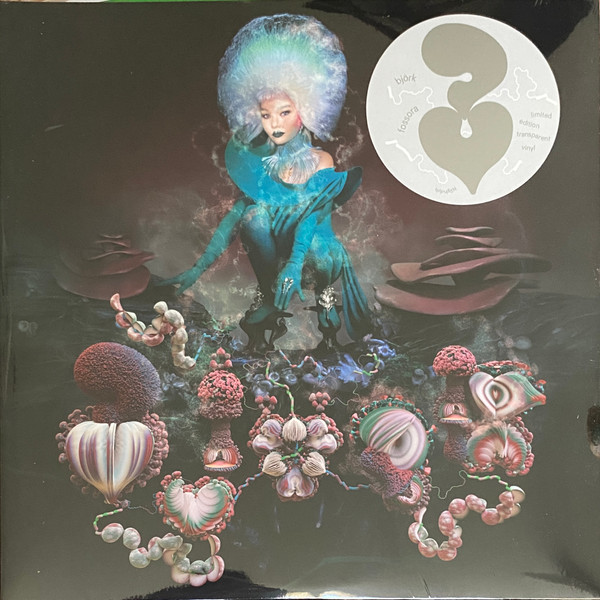
Bjork “Fossora”
Bjork’s music has become more and more sophisticated with each record and the recordings themselves have become more and more exquisite. Fossora is the latest in the line. Voices and wind instruments do most of the work on this one. At some point we’re going to have to say it, Bjork is becoming a classical composer. Ok, I said it now, I did. I played this record for a friend, we reclined on the couch, heads back, wordless for fifty-four minutes. (Plus, the time it took to flip the records.)
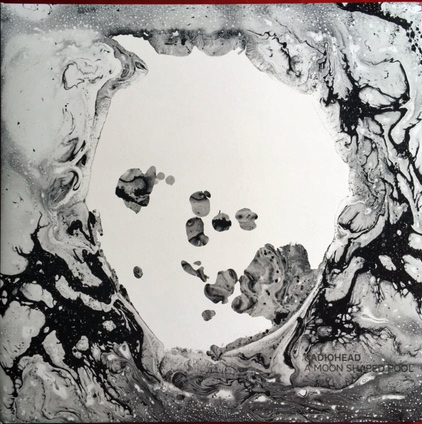
Radiohead “A Moon Shaped Pool”
I would like to recommend that everyone start using track 10 on this record, “Tinker Tailor Soldier Sailor Rich Man Poor Man Beggar Man Thief” as a reference track. As with “Warm Sounds” (and other tracks) by Zero 7, the electronic noises are so lovingly crafted, mesmerizing, and deep, I find them ideal for comparing systems or improvements to systems. In this case, I won’t say that I heard things I hadn’t heard before installing the Shunyata power distributor pair. Rather I would phrase it as hearing deeper into these weird and wonderful sounds. I think Radiohead started with a recording of the sound of a refrigerator on a defrost cycle and played with it in the studio for a week or so. Just thinking about it now and I’m more relaxed. With the Denali / Typhon T2 combo this track is now burned into my brain and I’m loving it.

I was blissing-out, digging through my vinyl collection but eventually remembered that I have a CD player – a fine one as these things go – the Parasound CD1. I connected it to the Denali with an old Venom HC cord (I have yet to part with any of the Shunyata cords I’ve purchased over the years).
Miho Hatori was one-half of Cibo Matto and has been making art ever since. “Ecdysis” has never been released on vinyl, sad. The CD has been a source of pleasure over the years though. With the Denali/Typhon combo in place, the improvements are similar to what happened with vinyl playback – there is a more natural and complete timbre for each and every one of the instruments or sounds. Voices, especially ones as magical as Miho’s, are more in-the-room and I hear more of the nuances and vocal touches. On the title track, Miho’s voice soared above the Bjork-like deep bass synth that anchors the track.
I wanted another magical voice, so I listened to Black Flower on Massive Attack’s best-of record, “Collected”. Elizabeth Frazier’s caramel-sweet tones wrapped around this tune like a double-dipped apple. I’ve also listened to this track on various systems to check how the rim-shot drum sounds. Once again, I had not heard before the wood of the stick – it was more the metal of the snare. The deep bass tones have a tune to them – not just a thump. I could hear more of that and now will be listening to the vinyl version soon.
My CD version of “Roseland NYC Live” by Portishead is from back in the day – 1998. It’s obviously a bit compressed compared to the vinyl. Wisely, Beth Gibbon’s vocals are not given that treatment. In spite of the soundstage being more solidly between the speakers, not extending beyond the speakers as with the vinyl version, and the instruments sounding less dramatic than with the vinyl, I still had to listen all the way through.
One last item to report about the CD1 plugged into the Denali – the CD1 has a switch to select between OpAmp or Discrete amplification for the final output stage. Previously, I was hard-pressed to note any difference between the two choices. Now, the discrete driver can be clearly heard as the better choice – more organic sounding, a slight glaze is removed.
What could be added to these two power distributors to make me even happier? In the sound department, I’ve been around long enough to know there are likely more improvements to be had out there, it’s hard to know what you’re missing though. So, I’ll concentrate on the looks department – let’s talk about this. The pre-Olympian god Typhon is among other things, a giant. Denali is a 20,000-foot mountain. When I think about what this combo does for the sound in my system, I feel like those names are correct, but I think I should see something big, imposing, a giant on a mountain or a giant mountain. As it is, the looks are rather unassuming.
Here are some pics to give an idea of the size, that’s a 10” Clash record.
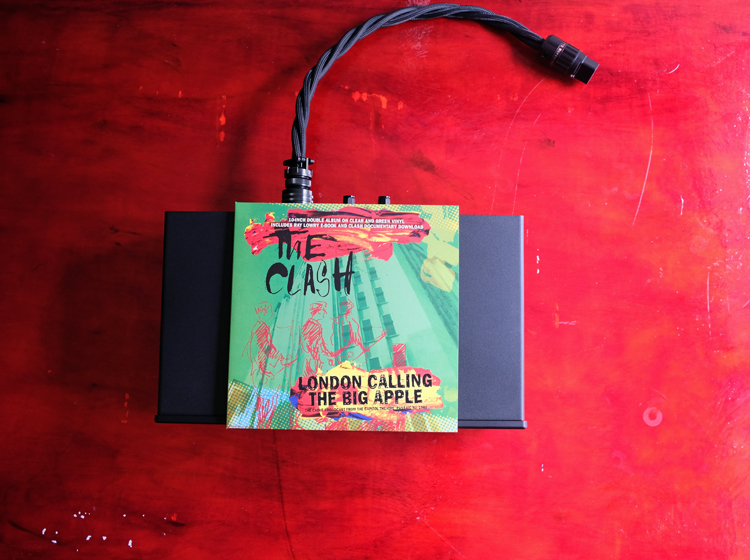
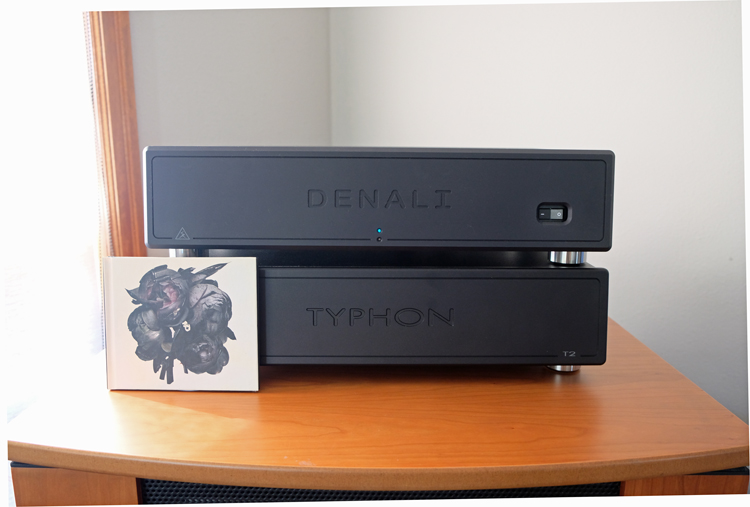
One very minor point – the Typhon T2 lacks the cable cradles that are on the Denali. In practice, you probably won’t care as the connections are pretty tight and it’s unlikely the cables will sag, at least with Shunyata cables. That’s the case for me. But it seems like the cradles should be there.
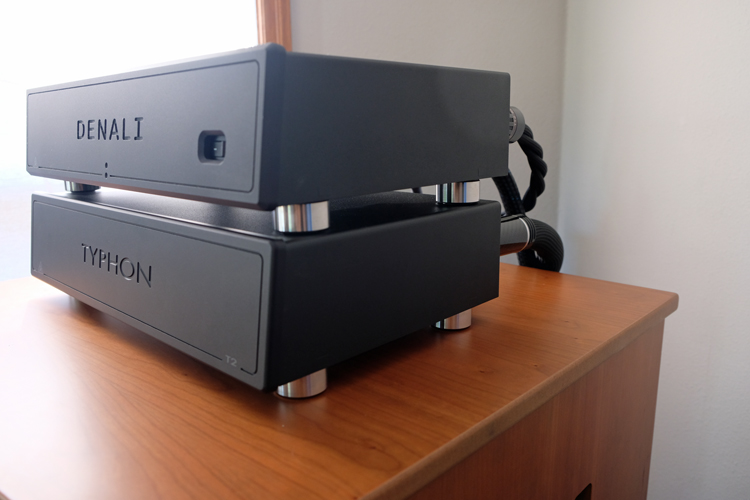
The Denali 6000/S v2 with the Typhon T2 added soundstage and musical details to my system to an extent I didn’t think was possible.
- Reveals the magic in my record collection.
- Two-box solution saves your back and makes for an upgrade path should you choose it.
- More dramatic styling
- Cable cradles on the Typhon T2
If we leave out the extensive and difficult technology descriptions in the Design section, this is one of the easiest reviews I’ve had the pleasure of writing in a long time. My readers (do I have readers?) will have heard me lamenting that it’s hard to find and describe differences between amplification products especially, no matter where they are in the chain. People are getting pretty good at designing those. Shunyata cords and power distributors on the other hand are different. And better. Better than any other things I’ve heard. (To be clear – they make the attached system, in this case, my attached system, better).
Audio reviewers struggle to find words, especially words that haven’t been used before. This creates a bit of review-inflation. On top of that, it’s considered bad form to always talk about this or that part of a recording we hadn’t heard before. I think this is because, with any change to a system, something or another will be emphasized more or less or just be different sounding, not necessarily better sounding. Fine, forget all that, with the Denali and then even more with the Denali 6000/S v2 / Typhon T2 combination, I kept hearing things I hadn’t heard, and, in each case, it was clear that I was hearing artistry and nuance in the performance that we are meant to hear on these recordings. Shunyata cords and power distributors get my highest recommendation. As tested, the cost is considerable, but you can get some benefit – probably more than you think – by starting with a single cord or two.
I’ve been adding Shunyata power cords over time (see below) to a Furman IT-Reference 20i. After switching to the Denali 6000/S v2 (even before adding the Typhon T2) I realized that the Furman was emphasizing certain (boomy) bass notes and that the top end had a fuzziness that the Shunyata power distributors completely cleaned up. Possibly this is what enabled the three-dimensional sound stage that emerged with the Denali/Typhon T2 combo.
Here is how I see my long journey with Shunyata, starting from the early days so each of these comments applies to a different generation:

Lush “Lovelife”
For example, the last song on Lush’s “Lovelife” is “Olympia” – it’s a deep cut, not something that would have been played on the radio back when there was such a thing. These days, I’m guessing it isn’t featured on computer-generated playlists either. The song is medium tempo and lacks the incredible hooks of the Lush hits. In the song singer Emma Anderson asks if she could ever be a perfect girl, like Olympia. She goes on to ask if there’s a way to cherish the moment and feel okay in the aftermath of pain. Heavy stuff that runs counter to the light melody that comes in as the song progresses and to the in-the-moment fun of the singing. Emma Anderson simply loves singing (she went on to form a band called Sing Sing) and I got the message of the song when a particularly playful touch spilled out of my speakers. I hate to geek out on even mentioning anything about stereo equipment at this point but – I had completely missed this tiny nugget of joy – Emma modulating her voice to match the excursions that the trumpet is making – until I had the Denali / Typhon T2 combo. It’s the kind of thing only an accomplished singer can pull off and when I heard it, I fell out of my chair for the umpteenth time.
My long history with Shunyata has me contemplating the optimal ratio of power cord and distributor cost to audio components cost. How to distribute limited funds? Having the Denali / Typhon T2 combination in my system has tilted the ratio solidly in the direction of upping the amount spent on the cord and distributor side. My Simaudio Moon W6 monoblocks are around 20 years old. They don’t come up for sale very often but when they do, they can be had for a song (pun!) compared to new components from that same company or others. I love them. I fear for their longevity though so might upgrade soon but as for the sound, when plugged into the Denali 6000/S v2 / Typhon T2 stack, I see no need to upgrade, I could easily live with this sound forever.
If I do get something new, the new component’s higher cost will be in part because of presumably better amplification circuits but also because of improved power supply circuits. Those power supply improvements are meant, in part at least, to deal with things that Shunyata deals with very well, thank you. In some cases, like the NR technology which addresses the hammer-effect noise that those same components send back upstream, affecting the other components, that’s Shunyata’s solution alone. Same with QR/BB, perhaps the most important part in the distributors. It’s hard to say which of the various Shunyata innovations is doing the trick because they are all working together but even standalone, the Shunyata solutions (cords and distributors) just work. There’s no guessing, no tilting your head trying to decide if the difference you hear is an improvement, it’s clearly better. More of what is on the recordings comes to your ears and you might be surprised at how much is on your recordings.


